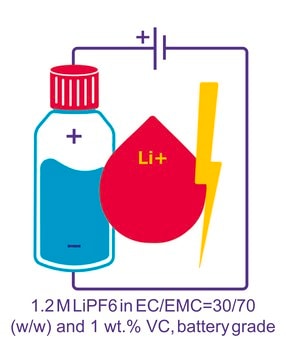934828
Lithiumhexafluorophosphat -Lösung
in ethylene carbonate and ethyl methyl carbonate with vinylene carbonate additive, 1.0 M LiPF6 in EC/EMC=30/70 (w/w) + 1 wt.% VC, battery grade
Synonym(e):
1.0 M LiPF6 in EC/EMC=30/70 (w/w) + 1 wt.% VC
About This Item
Empfohlene Produkte
Qualität
battery grade
Qualitätsniveau
Beschreibung
Application: Battery Manufacturing
Form
(clear liquid)
Grünere Alternativprodukt-Eigenschaften
Design for Energy Efficiency
Learn more about the Principles of Green Chemistry.
sustainability
Greener Alternative Product
Konzentration
1.0 M (LiPF6)
Verunreinigungen
≤100.0 ppm H2O
≤250.0 ppm KF
Farbe
colorless to faint yellow
Dichte
1.203 g/mL
Anwendung(en)
battery manufacturing
Grünere Alternativprodukt-Kategorie
SMILES String
F[P-](F)(F)(F)(F)F.[Li+]
InChI
1S/F6P.Li/c1-7(2,3,4,5)6;/q-1;+1
InChIKey
AXPLOJNSKRXQPA-UHFFFAOYSA-N
Suchen Sie nach ähnlichen Produkten? Aufrufen Leitfaden zum Produktvergleich
Allgemeine Beschreibung
Anwendung
Signalwort
Danger
Gefahreneinstufungen
Acute Tox. 4 Oral - Eye Dam. 1 - Flam. Liq. 2 - Skin Corr. 1A - Skin Sens. 1 - STOT RE 1 Inhalation - STOT RE 2 Oral
Zielorgane
Bone,Teeth, Kidney
Lagerklassenschlüssel
3 - Flammable liquids
WGK
WGK 2
Flammpunkt (°F)
69.8 °F
Flammpunkt (°C)
21 °C
Analysenzertifikate (COA)
Suchen Sie nach Analysenzertifikate (COA), indem Sie die Lot-/Chargennummer des Produkts eingeben. Lot- und Chargennummern sind auf dem Produktetikett hinter den Wörtern ‘Lot’ oder ‘Batch’ (Lot oder Charge) zu finden.
Besitzen Sie dieses Produkt bereits?
In der Dokumentenbibliothek finden Sie die Dokumentation zu den Produkten, die Sie kürzlich erworben haben.
Unser Team von Wissenschaftlern verfügt über Erfahrung in allen Forschungsbereichen einschließlich Life Science, Materialwissenschaften, chemischer Synthese, Chromatographie, Analytik und vielen mehr..
Setzen Sie sich mit dem technischen Dienst in Verbindung.












